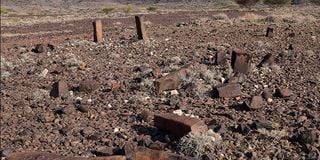5,000-year-old burial ground discovered in Lake Turkana

The Jarigole stone pillars.
Archaeologists have uncovered a 5,000-year-old cemetery on the eastern part of Lake Turkana, revealing the inner secrets of a stone pillar site that has always fascinated historians and anthropologists.
Recent excavations have unearthed an ancient cemetery containing whole bodies and disjointed skeletal remains.
The results of the excavations, which started in July 2019 at the Jarigole Stone Pillars site, have now been published in the latest issue of Antiquity Journal, a publication of Cambridge University.
“The new findings from the Jarigole site resolve long-standing questions about eastern Africa’s earliest monuments and provide insight into the social lives, and deaths, of the region’s first pastoralists,” says the study.
Also recovered in the pottery assemblage is an intriguing phallic bottleneck—the first of its kind to be found in eastern Africa. The archeologists have only noted this penis-like representation but have not interpreted its cultural meaning.
Jarigole is one of northern Kenya’s several stone pillar sites, previously considered to be ancient African astronomy sites. The most famous was the Namoratunga site on the western shores of Lake Turkana and Lothagam North, another cemetery site.
28 basalt pillars
The Jarigole site has interested researchers, who wondered what was beneath the 28 basalt pillars and the oval-shaped platform and mound. Preliminary investigations were carried out at the site between 1986 and 1996 by the National Museums of Kenya and the Koobi Fora Field School and recovered some fragmented human bones, ostrich egg-shell beads, and pottery.
But there was only speculation that this would be a secondary grave site, given that complete skeletons had not been recovered. It has now turned out that the cemetery was well planned and a lot of labour was put into it by a very complex pastoralist society.
“Our findings demonstrate that Jarigole’s construction began with the excavation of a planned mortuary cavity and the building of a surrounding circular stone platform. This platform consists of a series of short, basalt cobble retaining walls with rubble filling the spaces between them,” says the published study. The dead were buried together with their personal adornments, and one individual was found with “more than 100 amazonite and other stone beads near their neck and chest, which were perhaps worn as a necklace.”
The discovery of complete skeletons and also dismembered parts now suggests that this was both a primary and secondary burial site; meaning, it contained remains of individuals who may have been buried elsewhere before their remains were finally interred at the cemetery. According to the archaeologists, “parts of individuals who died elsewhere were routinely mixed into the fill, along with broken pots, beads and other offerings, potentially during and after the phases in which Jarigole was used for primary burial.”
But many questions still need to be answered on how long the pastoralists stayed with the dead before they eventually brought the remains to Jarigole.
“In addition, we do not know whether funerals were large gatherings or smaller affairs, why individuals were interred in primary versus secondary burials or perhaps scattered in the mortuary fill.”
There is a suggestion that people brought broken pots — or deliberately broke them – and buried them with human bones. Within the site is a distinctive pottery that has previously been dated to approximately 4,000 years ago. This pottery, first discovered in the central Rift Valley site of Nderit, was initially thought to have a central Kenya origin before researchers found that older pastoralist sites were prevalent in the Lake Turkana region.
The archaeologists have also compared the similarity between Jarigole and Lothagam North sites on the western side of the lake and concluded that “the people who constructed these sites followed a predetermined plan that began with a significant investment of labour to excavate a large area for burial.”
The researchers suggest that pastoralist “groups must have been within a few days’ walk from a pillar site to enable these burials, and/or funerary rituals” to take place or funerals “were important enough for people to cease other activities and travel whenever a death occurred.”





